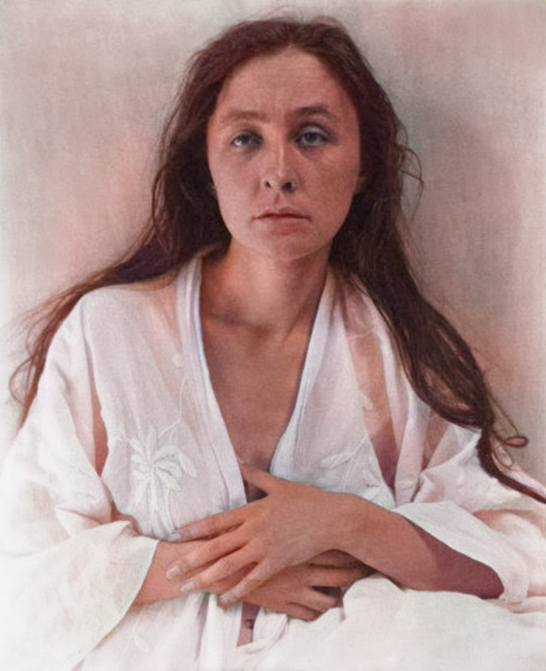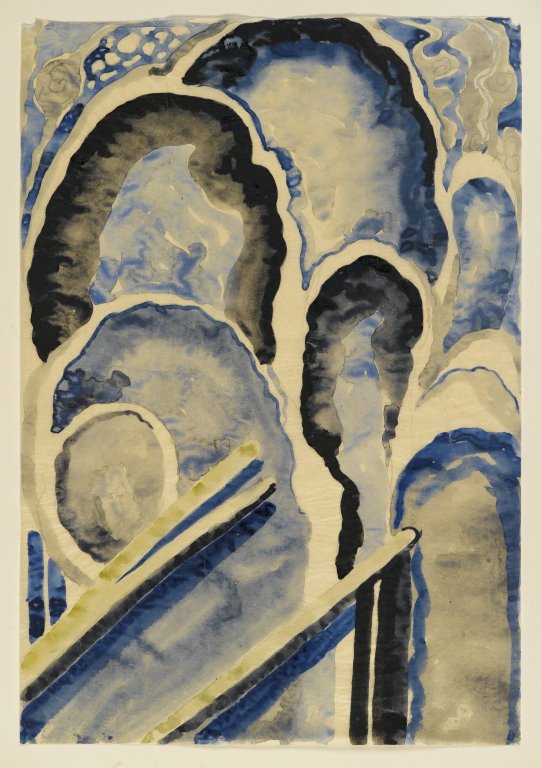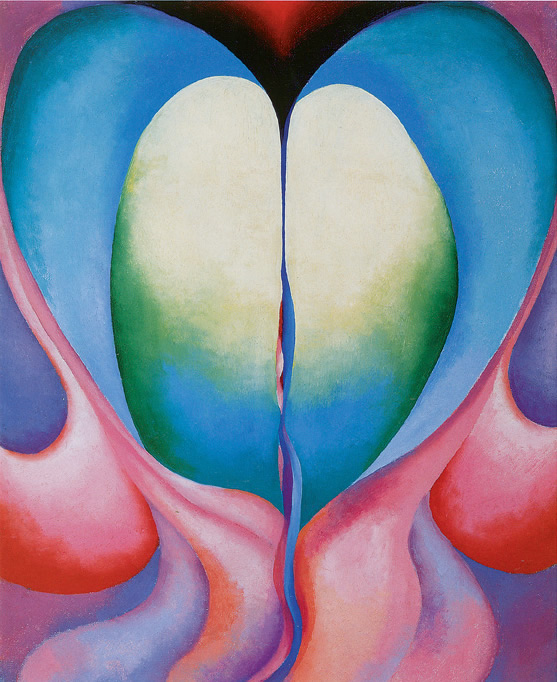
Georgia O’Keeffe (1887-1086), photo by Alfred Stieglitz [1], 1918
On November 15, 1887, American artist Georgia Totto O’Keeffe was born. She was best known for her paintings of enlarged flowers, New York skyscrapers, and New Mexico landscapes. O’Keeffe has been recognized as the “Mother of American modernism“.
‘I have things in my head that are not like what anyone taught me – shapes and ideas so near to me, so natural to my way of being and thinking’
– Georgia O’Keeffe
Georgia O’Keeffe – Youth and Education
O’Keeffe was born the second of seven children of the farmers Francis and Ida O’Keeffe. After selling the farm at Sun Prairie in Wisconsin, USA, the family moved to Williamsburg (Virginia) in 1903. Although she had numerous siblings, O’Keeffe grew up quite isolated and preferred nature, which stimulated her imagination, to society. Early on she expressed the desire to become a painter. After finishing high school at the Chatham Episcopal Institute (now Chatham Hall) in 1905, she attended art school at the Art Institute of Chicago from 1905 to 1906. For financial reasons she had to drop out of her studies there; afterwards she was enrolled as a student at the Art Students League in New York for one year from 1907 to 1908.
Alfred Stieglitz and the European Avantgarde
In 1908, an exhibition in Alfred Stieglitz‘s Galerie 291,[1] also visited by O’Keeffe, caused horror, showing a series of drawings by the French sculptor Auguste Rodin.[2] The seemingly simple drawings were more demanding than work sketches and thus contradicted the representational demands of conservative New York. Stieglitz was known for his provocative exhibitions of European avant-garde artists. The avant-garde works exhibited in Gallery 291, alongside Rodin for example by Picasso, Matisse and Cézanne, gave O’Keeffe impetus to find her own artistic signature. In his final work of the first year, however, O’Keeffe still oriented herself on the conservative demands of her teachers and was awarded the William Merrit Chase Prize for her still life in Oil “Untitled” (Dead Rabbit before Copper Pot), which was endowed with a summer course at Lake George.

O’Keeffe, Blue #1, 1916, watercolor and graphite on paper, Brooklyn Museum
Abstract Art and First Success
‘It is surprising to me to see how many people separate the objective from the abstract. Objective painting is not good painting unless it is good in the abstract sense’
– Georgia O’Keeffe, 1916
Financial difficulties forced O’Keeffe to leave the university. Between 1908 and 1910 she worked first as a commercial artist and later as an art teacher. During a summer course in 1912 at the University of Virginia in Charlottesville, she became acquainted with the theories of Arthur Wesley Dow, in particular his theory of composition, which offered O’Keeffe her first access to abstract art. Dow encouraged artists to express themselves with lines, colors, and harmonious shades. After further teaching she became a student of Dow at Columbia Teachers College in New York from 1914 to 1915. Then, O’Keeffe took up a teaching post again in the fall, now at Columbia College in Columbia, South Carolina, but this left her plenty of time for her own work. Under the impression of a love affair with a fellow student in New York, at the same time impressed by the landscape in the vicinity of her place of work and isolated apart from correspondence with her friend Anita Pollitzer, she was caught up in a creative crisis that led to a break with almost all of her previous works. A phase of self-discovery followed, in which she drew only with charcoal pencils on paper. Her friend Anita Pollitzer brought some of her works to Stieglitz. Stieglitz immediately recognized the outstanding artistic quality of these works and exhibited them in a group exhibition in late spring 1916. Through this he helped O’Keeffe to his first breakthrough.
Through the Magnifying Glass
In 1917, Stieglitz arranged O’Keeffe’s first solo exhibition of oil paintings and watercolours, which she had completed in Texas, but which was closed only three days after the opening due to the USA’s entry into the First World War. Stieglitz asked O’Keeffe to model for him and took her first photographs. An intense love affair developed between the two, although Stieglitz was 23 years older, in the course of which Stieglitz divorced Emmeline Obermeyer after 24 years of marriage in 1918. By early 1918 O’Keeffe had met many early American modernists and soon after, she began to work primarily in oil, a step away from the watercolors she had mainly worked on in the early 1910s. In the mid-1920s, O’Keeffe began large-format paintings of natural forms at close range, such as through a magnifying glass. In 1924 she painted her first large-format flower painting, Petunia, No. 2, which was first exhibited in 1925.

O’Keeffe, Series 1, No. 8, 1918, oil-painting on canvas, 50.8 × 40.6 cm, Lenbachhaus, Munich
The Representational and Feminism
‘The abstraction is often the most definite form for the intangible thing in myself that I can only clarify in paint’
– Georgia O’Keeffe
O’Keeffe turned more and more to the representational. Her earlier works had mostly been abstract, but works such as Black Iris III (1926) evoke interpretation as a veiled representation of the female genitals and at the same time a precise representation of the centre of an iris. O’Keeffe always denied the validity of the Freudian interpretations of her art, but even 50 years later many well-known feminist artists rated her work similarly. Although the feminists of the 1970s celebrated O’Keeffe as the creator of “feminine iconography,” O’Keeffe rejected her glorification of her work and refused to participate in any of her projects.
Transition and Further Success
Some time after the marriage there were quarrels with Stieglitz. Following an invitation, she travelled to Taos in New Mexico in the spring of 1929. The unspoiled nature left strong impressions in her. In the following three years O’Keeffe suffered depressive episodes and finally a nervous breakdown in 1933. She had to seek psychiatric help, was admitted to hospital in early 1933 and then recovered on the Bermuda Islands. After the nervous breakdown, it took a year before she became active again as a painter. Starting in 1933, she regularly spent about half of every year in New Mexico, collecting stones and bones in the desert and making them and the unmistakable architectural and landscape forms of the region the theme of her works. In the summer of 1934, she first visited the Ghost Ranch north of Abiquiu and in 1940 moved into a house on the farm property. The area’s multicolored cliffs inspired some of its most famous landscapes. In the 1930s and 1940s, O’Keeffe’s reputation and popularity continued to grow, earning her numerous commissions. Her work was exhibited in and around New York. She completed Summer Days, a painting depicting a deer skull adorned with various wild flowers, one of her most famous and famous paintings. In the 1940s, O’Keeffe had two retrospectives, the first at the Art Institute of Chicago (1943). The second in 1946 at the Museum of Modern Art (MoMA) in Manhattan was the first retrospective that MoMA organized for an artist.
Later Years
Shortly after O’Keeffe arrived in New Mexico in 1946 for her summer stay, Stieglitz suffered from brain thrombosis. He died in New York on July 13, 1946, and she buried his ashes at Lake George. O’Keeffe spent the next three years mostly in New York to settle his estate, and moved permanently to New Mexico in 1949. From 1946, she made the architectural forms of her Abiquiu house the themes of her work. Another unmistakable painting of the decade was Ladder to the Moon, 1958. She continued to make long walks, this time in the desert and mountains around Santa Fe. Inspired by this barren, misanthropic landscape, O’Keeffe expanded her motifs to include wind-polished bones and the rocks of the surrounding area. At over 80, O’Keeffe embarked on her first trip around the world. Once again, a new motif found its way into her work: cloud formations seen from the window of an airplane. With the support of her then partner Juan Hamilton, she worked – increasingly deprived of her sight – on her last pictures, which thematized all oversized cloud landscapes. From the mid-1970s, she experimented with clay works. O’Keeffe died blind at the age of 98 on 6 March 1986 in Santa Fe.
O’Keeffe on Camera: Capturing an American Icon, [8]
References and Further Reading:
- [1 ] Alfred Stieglitz and Photography as Art, SciHi Blog
- [2] Auguste Rodin – Progenitor of Modern Sculpture, SciHi Blog
- [3] Georgia O’Keeffe at the Museum of Modern Art
- [4] Georgia O’Keeffe, Archives of American Art, Smithsonian Institution
- [5] O’Keeffe, Georgia (1988). Some Memories of Drawings. Albuquerque, NM: University of New Mexico Press.
- [6] Giboire, Clive, ed. (1990). Lovingly, Georgia: The Complete Correspondence of Georgia O’Keeffe & Anita Pollitzer. New York: Simon & Schuster.
- [7] Georgia O’Keeffe at Wikidata
- [8] O’Keeffe on Camera: Capturing an American Icon, including filmmaker Perry Miller Adato and photographers Christopher Makos, Tony Vaccaro, and Malcolm Varon. Moderated by Wanda Corn, guest curator of Georgia O’Keeffe: Living Modern. Brooklyn Museum @ youtube
- [9] Timeline for Georgia O’Keeffe, via Wikidata





